Fujifilm X10 Review
Fujifilm X10
Is the X10 the ultimate advanced compact?
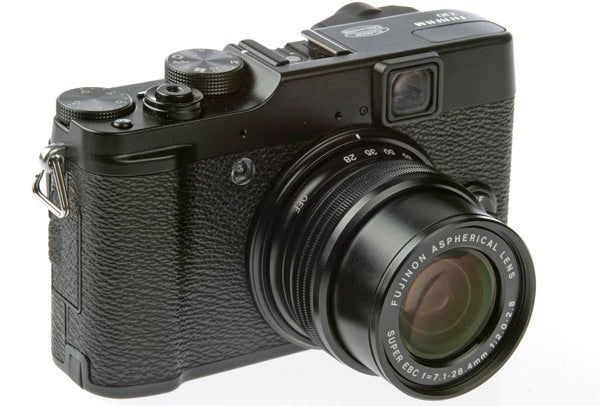
Verdict
Pros
- Fantastic styling and solid build quality
- Manual zoom control is more intuitive
- Optical viewfinder is large and bright
- Useful EXR and Advanced shooting modes
- Fast Fujinon lens produces sharp, bright images
Cons
- Produces ugly white discs in place of highlights
- White balance can take time to adjust
Key Specifications
- Review Price: £499.00
- 12-megapixel EXR CMOS sensor
- Dual-core EXR image processor
- 28-112mm (4x) manually operated zoom lens
- ISO 100 - 12,800
- 1080 Full HD movie recording at 30fps
The X10 is still very much an enthusiast-level, premium-grade camera though, and as such it’s most likely to appeal to DSLR owners looking for something that’ll comfortably slip inside a jacket pocket and yet still deliver the flexibility and user experience of a DSLR. That said, the X10 also makes some concessions towards more casual users by offering a number of fully automatic exposure options, including Fuji’s proprietary EXR shooting modes that have proved so popular on other Fuji models.
The main differences between the two X-series models are that whereas the X100 sports an APS-C sized sensor, the X10 uses a newly developed 2/3inch chip. In terms of overall surface area this new Fuji sensor is fractionally larger than the 1/1.6inch and 1/1.7inch sensors used by the X10’s main rivals, namely the Panasonic Lumix LX5, Olympus XZ-1, Samsung EX1, Nikon P7100 and Canon G12, as well as being approximately twice the size of the regular 1/2.3inch sensors found in the vast majority of cheap to mid-range compacts and superzooms. The X10’s 2/3in sensor is, however, considerably smaller than either Micro Four Thirds or APS-C. For more about sensor sizes, check out Wikipedia’s comprehensive sensor size comparison page.

Another big difference between the X10 and X100 is that the X10 gets a manually operated 4x zoom lens, whereas the X100’s optic is fixed at 35mm. The X10 lacks a dedicated aperture ring too, with all shutter/aperture adjustments made via the thumbwheel on the back of the body. Finally, the X10 doesn’t get the hybrid optical/EVF viewfinder of the X100 either, although it does sport a larger than average conventional viewfinder. The two cameras do share the same retro rangefinder styling though, along with the same high level of overall build quality.
The X10 is equipped with a fixed 4x Fujinon zoom lens that is manually operated and offers the equivalent range of 28-112mm in 35mm terms. Maximum aperture at 28mm is a usefully quick f/2, rising to a still very impressively quick f/2.8 at 112mm. While 28mm isn’t quite as wide as we’d ideally like, it is on a par with all of its main rivals. Indeed of all the fixed-zoom advanced compacts mentioned above, only the Panasonic Lumix LX5 is wider at 24mm. It’s worth noting, however, that this advantage is balanced by the LX5’s shorter 90mm telephoto maximum, it’s also slower (f3.3) at this focal length.
So, does all of this add up to Fuji’s best X-series digital camera to date, or does the X10 fall short in other, less obvious, areas?. Let’s take a closer look and find out…
As mentioned previously the X10 uses an all-new 2/3inch EXR CMOS sensor that delivers an effective resolution of 12MP, and which is backside-illuminated for better low-light performance. As with all Fuji EXR sensors, the chip inside the X10 employs a unique pixel arrangement that allows neighbouring pixels to be combined when necessary to increase sensitivity in low-light conditions, but which can also act independently to deliver maximum resolution.
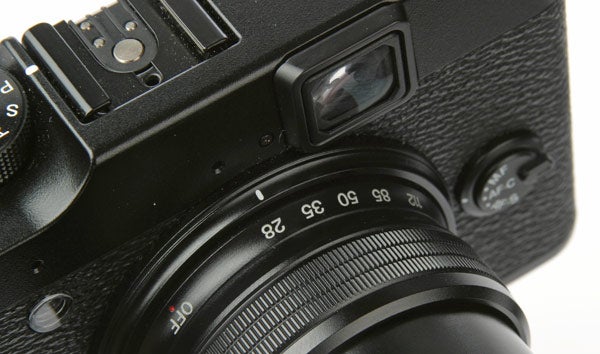
Maximum output at full resolution in the default 4:3 aspect is 4,000 x 3,000 pixels, although the camera also offers Medium (6MP) and Small (3MP) resolution settings too. It’s also possible to shoot in 3:2, 16:9 and 1:1 aspects, albeit at slightly reduced overall resolutions. There are two JPEG quality settings: Fine and Normal. You can expect a regular JPEG file shot at full resolution on the Fine setting to measure around 5MP in size.
In addition to JPEG capture, the X10 can also record lossless sensor data as Raw image files (Fuji’s .RAF format, which at the time of writing is still awaiting Adobe/Apple support, but which will doubtless arrive soon). Raw files allow you to get the best from your photos by ensuring every detail of data is retained, rather than being lost through JPEG compression, but file sizes can be very large. We especially like how the X10 offers a dedicated Raw button on the back of the camera that allows you to select Raw capture on the fly as and when you think a shot merits it, without having to fiddle about in the in-camera menu.
Sensitivity ranges from a baseline ISO 100 up to ISO 12,800 in standard mode, with sensitivity rises offered incrementally (i.e. from ISO 200 to ISO 250) rather than just ‘doubling up’ (i.e. from ISO 200 to ISO 400) as is more commonplace. There’s no dedicated ISO button on the camera, although you can assign that function to the Function (Fn) button on the top-plate should you wish to.
In keeping with its advanced-compact positioning, the X10 offers a generous range of exposure modes, with the semi- and fully-manual creative quartet of Program, Aperture-priority, Shutter-priority and Manual (PASM) complimented by a fully Automatic mode, 16 individual Scene Position (SP) modes, and two user-defined Custom modes. In addition to these, the X10 also offers three Advanced shooting modes and three EXR-specific modes, all of which are worth a closer look.
The three Advanced modes are Motion Panorama, Pro Focus, and Pro Low-Light. The first of these, Motion Panorama, allows you to create 120, 160 or 360-degree panoramas by simply sweeping the camera in a predetermined direction with the shutter button held down. Once you’ve mastered the technique, the results can be very good indeed. Pro Focus, meanwhile, is a portrait-specific mode that enables you to create a shallow depth of field effect by taking multiple images and then processing added blur into the background. Lastly, Pro-Light Mode is another mode that uses multiple exposures, this time with the aim of reducing the effects of noise in low light.
The three EXR modes, meanwhile, include a High Resolution mode, a Dynamic Range Priority mode and a High ISO & Low Noise mode. As the name implies High Resolution mode prioritises resolution above all else, while Dynamic Range takes two images simultaneously and them combines them into a single (6MP) image. Lastly, High ISO & Low Noise mode takes advantage of the unique EXR pixel arrangement to combine pixels and reduce noise. Images shot in this mode are captured at 6MP, but the reduction in noise is pretty impressive.
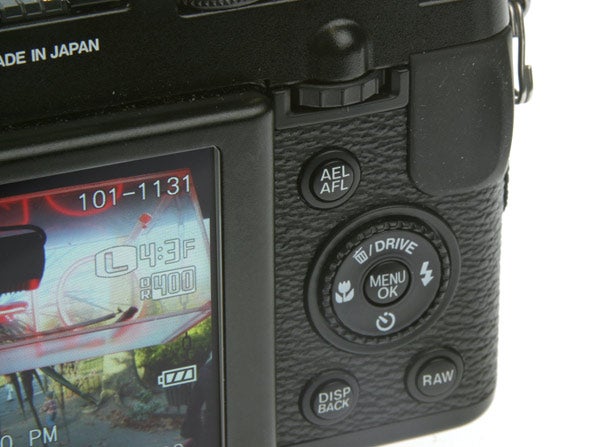
In terms of video capture, the X10 offers a top setting of 1080p Full HD at 30fps, ably supported by 720p HD and VGA (640 x 480) capture. Furthermore, the X10 also draws upon Fuji’s expertise in high-speed video capture (something the company has been equipping its bridge cameras with for many years), with the option to record high-speed movies (that play back in slow-motion) at either 120fps at 320 x 240 (QVGA quality) or 200fps at 320 x 112 pixels. Sound is captured in stereo via two microphones on the front of the camera, but there’s no external microphone port. Movies are stored as H.264 (.MOV) files.
Elsewhere, you will find that the X10 offers a very good range of customisation options and settings with which you can tinker to alter the overall look and feel of your photos. These include everything from Film Simulation controls that are named after (and mimic the look of) classic Fuji 35mm film stock, to Dynamic Range controls (from 100% to 400%). In addition, there are separate controls for Colour saturation, Sharpness, Highlight Tones, Shadow Tones and Noise Reduction too – with five levels of strength for each to choose from.
Add to this Face Detection and Face Recognition options, a good selection of bracketing options and a passable ‘intelligent digital zoom’, and the X10 adds up to a very well featured camera indeed. The only contemporary ‘must-have’ feature the X10 really lacks is a set of digital filter effects; if you want to give your images a miniature model or cross-processed look you’ll need to take a regular photo and get busy in Photoshop instead.
I’m going to have to hold my hands up from the outset and say that I think the X10 is the most stylish camera I’ve reviewed this year. Its retro rangefinder design might not appeal to everyone, but personally I think it looks absolutely fantastic. What’s more, it’s an extremely tactile camera too. Picking it up for the first time, everything about it – from the metal zoom ring to the machined Exposure mode/EV control dials – feels measured, precise and of premium quality. It all adds up to a camera that’s very hard to put down, even if you’re not actually taking any pictures.
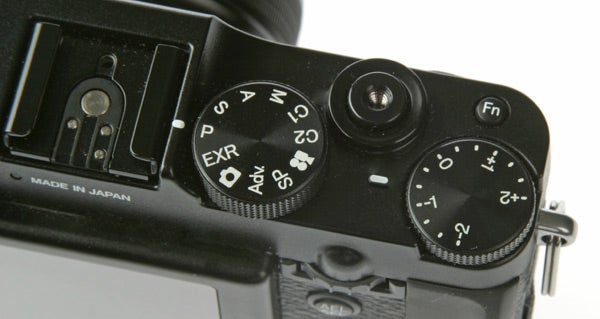
With a die-cast magnesium top and bottom plates and metal dials/zoom ring, overall build quality is perhaps the best in its class. Of course you still wouldn’t want to drop it, and to this end the X10 gets a relatively low-profile finger grip that’s covered in synthetic leather for added grip, along with a moulded thumb rest on the back. An eyelet on each shoulder also allows you to attach the supplied neck strap – the use of which is something of a no-brainer really; not only because it’s safer, but also because you’ll probably want to show your new pride and joy off to all and sundry.
On the back of the camera you’ll find a good array of physical buttons, including the aforementioned dials on top of the camera that are used to set exposure mode and dial in EV compensation. Elsewhere on the body you’ll find buttons that offer direct access to the most commonly used stings such as AF mode (Single, Continuous, Manual), Metering mode (Multi, Spot or Average), AF point control (only accessible when the camera is set to AF-S), White Balance, Drive mode, Flash control, Self-timer, Raw image capture and Macro mode.
Next to the thumb rest you’ll find a clickable control wheel, which is used to control aperture or shutter speed (or indeed both when the camera is being used in Manual mode). Below this is an AEL/AFL button that can be used to lock exposure (or focus) in tricky metering situations.
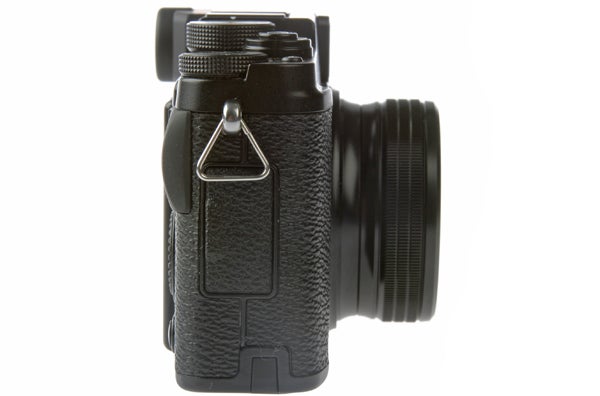
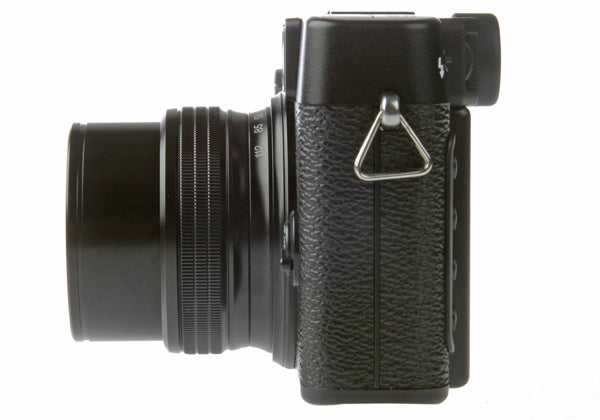
The X10’s zoom is operated manually via a machined metal ring that runs around the lens and, rather neatly, this also doubles up as the camera’s main on/off switch. We’re big fans of this approach as having to manually adjust focal length – as you would with a DSLR – makes framing a far more intuitive, precise and speedy process than trying to feather and nudge a spring-loaded zoom control to the exact focal length you want. Should you wish to focus manually, you can do so via the thumb wheel that encircles the D-pad.
It’s worth noting that the X10 is supplied with a metal lens cap that needs to be removed (and stored in a pocket or suchlike) in order to reach the zoom ring and turn the camera on. However, if you just want to review stored images without having to go through this process then pressing and holding the ‘green triangle’ button switches the camera straight on into Playback mode.
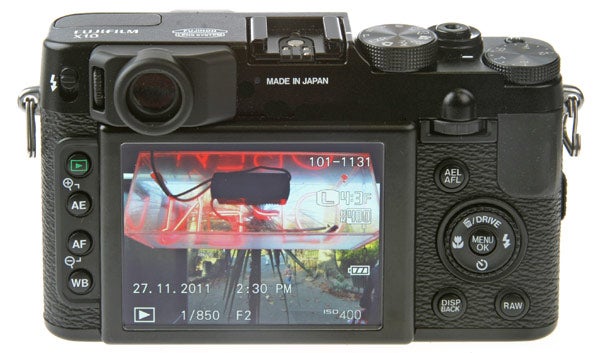
The back of the X10 is adorned with a 2.8inch, 460k-dot TFT LCD monitor that offers 100% coverage and good viewing angles. Should you prefer, and many DSLR owners almost certainly will, you can also frame shots using the optical viewfinder. This is considerably larger and brighter than the viewfinders found on competitor models like the Nikon P7100 or Canon G12, although it does need bearing in mind that the slightly offset field of view (it’s not looking directly through the lens) and 85% frame coverage mean it should only be used as a guide rather than a precise framing tool. Even taking this into consideration, the X10’s viewfinder comfortably blows all of its rivals clean out of the water and remains a great way to frame your shots in bright conditions or when you just want to be isolated from the world around you and concentrate on your shot. A dioptre dial also means you can adjust the viewfinder focus so those that normally require glasses can do away with them for framing their shots (depending on your prescription).
AF performance is impressive too, with focus-lock close to instantaneous in good light and only dipping slightly in dimmer conditions. In really dark conditions, where there isn’t enough light for the 49 AF points to lock on, an AF assist light on the front of the camera can be called upon to light up near subjects.
Start-up time impresses, with the time taken from the camera being switched off to capturing a fully focused shot clocking in at around a second. The X10’s no slouch in Single-shot drive mode either, with the dual-core EXR image processor taking around half a second to process each shot. There are a large number of Continuous shooting options too. Shooting at full resolution, the maximum speed possible is a nimble 7fps, which is pretty quick even for a camera of this calibre. Lowering resolution to Medium (6MP) or Small (3MP) pushes this up to 10fps.
Overall image quality is superb, with the X10 able to deliver consistently sharp, bright and vibrant images. The Fujinon optic particularly impresses, delivering very high levels of corner to corner sharpness while resolving plenty of fine detail too. Thanks to the use of three ED elements within the 9-group/11-element lens configuration purple fringing is notably absent on high-contrast borders. The Macro mode is perhaps the best we’ve yet seen in a camera of this type, with an additional Super Macro setting letting you get as close as 1cm away from your subject. If you’re a fan of photographing small things then the X10 is an ideal camera for you.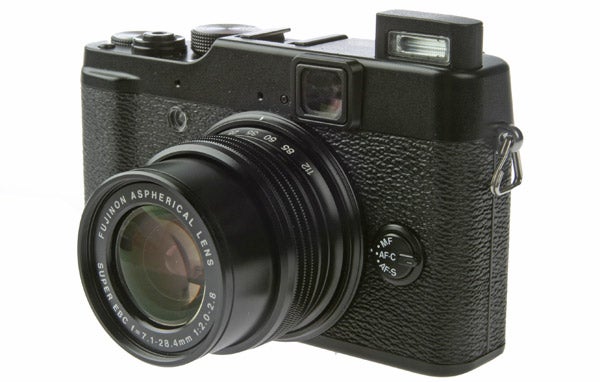
Given the wealth of in-camera options that allow you to adjust image settings, it’s possible to set the X10 up in advance to deliver exactly the kind of image you want. This is most likely something you’ll want to experiment with and then leave (perhaps assigning a couple of choice settings to one of the two Custom settings on the main mode dial for quick access). For testing purposes we were happy to stick with the factory standard set-up, with all colour, sharpness and tone curve settings set to Standard.
And so to the one major chink in the X10’s otherwise impenetrable armour: the widely reported appearance of ugly white discs in place of specular highlights. To be honest, in the hundreds of test images we took with the X10 we only found this to be a real problem on a relatively small number of images and even then you often have to go looking for them (see the Sample Images: General Images page for an example). And as reported elsewhere, the problem does seem to be more pronounced at low sensitivities, ISO 100 particularly.
Still, that doesn’t excuse the phenomenon and it isn’t really acceptable for a £500 camera to be producing such aberrations like this at all. Fuji is aware of the issue and has, only today, released a statement recognising it as a cause of “concern” for consumers. Furthermore, Fuji believe the problem is the result of a “blooming” (pixel overload) issue that the company claims is “not uncommon to many types of digital camera”. More importantly, Fuji has pledged to release a firmware update to “lessen the effect”.
The white disc issue is a real shame, simply because the X10 shines in so many other areas. Metering is taken care of via a TTL 256-zone module and proves consistently accurate, especially when exposing for evenly-lit scenes. In trickier situations you can always call upon the AEL button to lock down the exposure as you see fit and then compose your image as planned.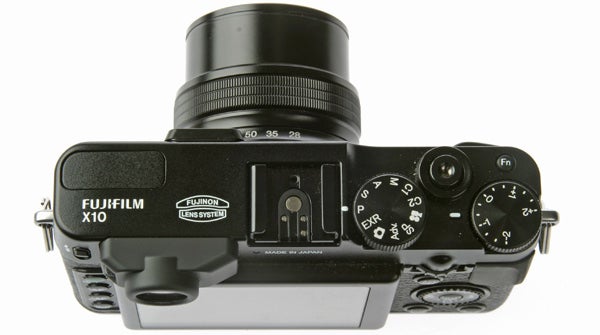
Alternatively, you can increase the X10’s dynamic range, right up to 400%. Used in this way the X10 delivers pretty good results in high-contrast lighting situations; even when cranked up to the maximum 400% images shot in this way still maintain a fairly lifelike appearance, although we did notice a slight tendancy for blue skies to turn a little cyan – something the X100 is also guilty of to an extent. Tonality is another area where the X10 delivers pleasing results with good levels of contrast, even with all tonal settings set to ‘Standard’.
Sensitivity performance is very good too, with images shot at or under ISO 400 free of noise. The X10 particularly impresses in the mid-range; from ISO 800 to ISO 3200 too, which are the kind of settings you might find yourself using in dark shade or under dim artificial lighting. At all of these settings we were able to capture images that, while hardly free of noise or the effects of noise-reduction processing, were still perfectly usable. Higher up the scale at ISO 6400 and ISO 12,800 quality does drop off quite significantly though, with the effects of processing quite noticeable. Special mention must go to the EXR High ISO and Low Noise mode, which we found to produce very usable images, especially for use at smaller sizes or on the web.
We didn’t experience any problems with automatic white balance, although we noticed with a fair bit of regularity that the camera can take a second or two to adjust when switching from natural light to artificial light (and vice versa).
Verdict
In many ways the X10 is the best advanced compact we’ve ever laid our hands on. Not only does it look super stylish, it also handles fantastically while offering a rich feature-set that’ll appeal as much to casual photographers as it will to enthusiasts. The manual zoom control, large optical viewfinder and DSLR-like handling are the X10’s undoubted highlights. And while general image quality is some of the best we’ve yet seen in an advanced compact, the white discs issue does present a problem. For this reason we’ve docked a point from the overall score. However, if Fuji makes good on its promise to fix this with an upcoming firmware update then we’ll happily adjust our score upwards, as in just about every other aspect the X10 is a 10/10 camera.

ISO 100 offers sharp edges, good detail in shadow areas and is free of noise.

ISO 200 shows no visible difference from ISO 100

ISO 400 is still free of noise with very good shadow detail.

Whereas many compacts start to become unstuck at ISO 800, the X10 is still producing clear shots.

At ISO 1600 shadow detail begins to soften as the X10’s noise-reduction processing kicks in.

At ISO 3200 the image has become noticeably softer, but the X10 can still produce usable images which is hugely impressive for a camera of this size.

ISO 6400 is where things start to really break down.

ISO 12800 isn’t somewhere you want to go if you can possibly help it.

A real-life example of a perfectly usable shot taken at ISO 1600. Click to expand to actual size.

And the same image once more, this time with the X10 set to ISO 3200. Again, click to view at actual size.

Overall image quality is very good, especially when the X10 is faced with a relatively evenly-lit scene like this.
(1/400sec @ f/4, ISO 100, 44mm, AWB)

Saturation levels can be boosted by switching to the ‘Velvia’ film simulation.
(1/250sec @ f/5.6, ISO 200, 28mm, AWB)

At its baseline sensitivity of ISO 100 the X10 produces vibrant, richly toned images.
(1/70th sec @ f/2.2, ISO 100, 36mm, AWB)

Used in standard mode, the X10 delivers lifelike colour.
(1/38sec @ f/2.8. ISO 400, 28mm, AWB)

The X10’s lens is capable of resolving good levels of detail.
(1/180sec @ f/2.5, ISO 200, 28mm, AWB)

At mid-range sensitivities, such as ISO 800, the X10 is still able to deliver very good results.
(1/60sec @ f/2.8, ISO 800, 112mm, AWB)
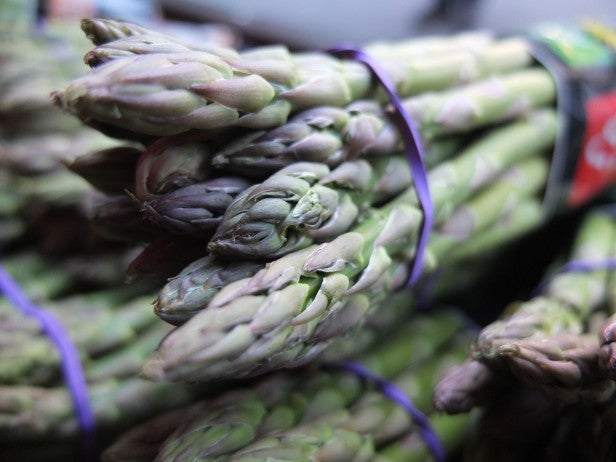
The X10’s Macro (and Super Macro) modes are especially impressive.
(1/160sec @ f/2, ISO 400, 28mm, AWB)

At the other end of the scale, the X10 offers an ‘Intelligent Digital Zoom’ that offers passable – if not great – results.
(1/75sec @ f/2.8, ISO 800, 112mm with IDZ on, AWB)

The X10’s built-in Image Stabilisation allows you to shoot sharp pictures at slower shutter speeds.
(1/ 20sec @ f/4, ISO 400, 28mm, AWB)
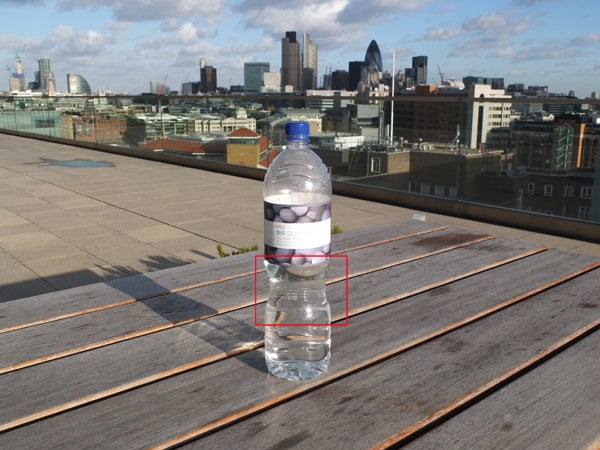
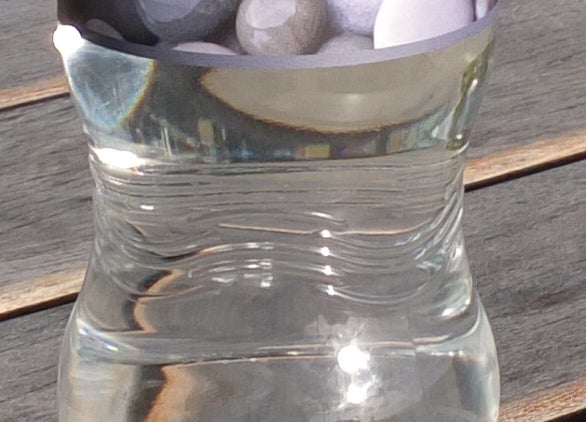
And so to the well ‘white discs’ issue. The 100% crop directly above illustrates how the X10 turns specular highlights into white discs. Fuji claim this is due to a blooming issue and have pledged to address the problem with a firmware update.
Trusted Score
Score in detail
-
Value 9
-
Design & Features 10
-
Image Quality 9
-
Build Quality 10

